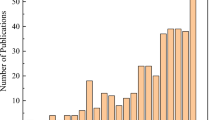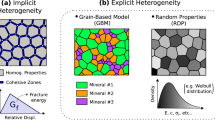Abstract
The Johnson–Cook (JC) model can give an accurate estimate of the flow stress at the low strain rate and temperature, but fails to predict the flow stress under high strain rate and elevated temperature due to the complex relationship among strain, strain rate and temperature. The Zerilli–Armstrong (ZA) model is capable to provide a higher prediction accuracy of material flow stress, but is unable to describe the material behavior above the limitation temperature (0.6Tm). In this research, an integrated JC–ZA model, which considers the grain size, strain hardening, strain rate hardening, thermal softening and the coupled effects of strain, strain rate and temperature, is proposed. The effects of strain rate and temperature on the flow stress of Ti–6Al–4V are investigated by quasi-static tensile test and dynamic split Hopkinson pressure bar test. It is proved that the integrated JC–ZA model has a similar accuracy with JC model at low strain rate and temperature with a prediction error of 2.180–2.358%, and a higher accuracy at high strain rate and elevated temperature with a prediction error in the range of 0.174–2.358%. Through this research, an accurate model by integrating JC model and ZA model for the flow stress of Ti–6Al–4V is given.












Similar content being viewed by others
References
Poondla N, Srivatsan TS, Patnaik A, Petraroli M (2009) A study of the microstructure and hardness of two titanium alloys: commercially pure and ti-6al-4v. J. Alloys Compd. 486:162–167
Kotkunde N, Krishnamurthy HN, Puranik P, Gupta AK, Singh SK (2014) Microstructure study and constitutive modeling of Ti-6Al-4V alloy at elevated temperatures. Mater Des 54:96–103
Donachie MJ Jr (1988) Titanium: a technical guide. ASM International, Metals Park, pp 353–365
Wessel JK (2004) Handbook of advanced materials. Wiley, Somerset
Yang X, Liu CR (1999) Machining Titanium and its alloys. Mach. Sci. Technol. 3:107–139
Sima M, Ozel T (2010) Modified material constitutive models for serrated chip formation simulations and experimental validation in machining of titanium alloy Ti-6Al-4V. Int. J. Mach. Tool Manuf. 50:943–960
Byrne G, Dornfeld D, Denkena B (2003) Advancing cutting technology. Ann CIRP. Manuf. Technol. 52:483–507
Ozel T, Sima M, Srivastava AK, Kaftanoglu B (2010) Investigations on the effects of multi-layered coated inserts in machining Ti–6Al–4V alloy with experiments and finite element simulations. Ann CIRP. Manuf. Technol. 59:77–82
Lin YC, Chen XM (2011) A critical review of experimental results and constitutive descriptions for metals and alloys in hot working. Mater Des 32:1733–1759
Johnson GR, Cook WH (1983) A constitutive model and data for metals subjected to large strains, high strain rates and high temperatures. In: Proceedings of the 7th international symposium on ballistics, The Hague, The Netherlands, pp 541–547
Johnson GR, Cook WH (1985) Fracture characteristics of three metals subjected to various strains, strain rates, temperatures and pressures. Eng Fract Mech 21:31–48
Gao CY, Zhang LC (2010) A constitutive model for dynamic plasticity of FCC metals. Mater Sci Eng, A 527:3138–3143
Kotkunde N, Deole AD, Gupta AK, Singh SK (2014) Comparative study of constitutive modeling for Ti-6Al-4V alloy at low strain rates and elevated temperatures. Mater Des 55:999–1005
Zhang DN, Shangguan QQ, Xie CJ, Liu F (2015) A modified Johnson–Cook model of dynamic tensile behaviors for 7075-T6 aluminum alloy. J. Alloys Compd. 619:186–194
Tan JQ, Zhan M, Liu S, Huang T, Guo J, Yang H (2015) A modified Johnson–Cook model for tensile flow behaviors of 7050-T7451 aluminum alloy at high strain rates. Mater Sci Eng, A 631:214–219
Zerilli FJ, Armstrong RW (1987) Dislocation‐mechanics‐based constitutive relations for material dynamics calculations. J Appl Phys 61:1816–1825
Gao CY, Zhang LC, Yan HX (2011) A new constitutive model for HCP metals. Mater Sci Eng, A 528:4445–4452
Lennon AM, Ramesh KT (2004) The influence of crystal structure on the dynamic behavior of materials at high temperatures. Int J Plast 20:269–290
Liu R, Melkote S, Pucha R, Morehouse J, Man XL, Marusich T (2013) An enhanced constitutive material model for machining of Ti-6Al-4V alloy. J Mater Process Technol 213:2238–2246
Samantaray D, Mandal S, Borah U, Bhaduri AK, Sivaprasad PV (2009) A thermo-viscoplastic constitutive model to predict elevated temperature flow behaviour in a titanium modified austenitic stainless steel. Mater Sci Eng, A 526:1–6
Lin YC, Chen XM (2010) A combined Johnson–Cook and Zerilli–Armstrong model for hot compressed typical high-strength alloy steel. Comput Mater Sci 49:628–633
Arisoy YM, Ozel T (2015) Prediction of machining induced microstructure in Ti–6Al–4V alloy using 3-D FE-based simulations: Effects of tool micro-geometry, coating and cutting conditions. J Mater Process Technol 220:1–26
Rotella G, Umbrello D (2014) Finite element modeling of microstructural changes in dry and cryogenic cutting of Ti6Al4V alloy. Ann CIRP. Manuf. Technol. 63:69–72
Khan AS, Suh YS, Kazmi R (2004) Quasi-static and dynamic loading responses and constitutive modeling of titanium alloys. Int J Plast 20:2233–2248
Zerilli FJ, Armstrong RW (1996) Constitutive relations for titanium and Ti-6Al-4V. AIP Conf Proc 370:315–318
Nadai A, Manjoine MJ (1941) High-speed tension tests at elevated temperatures. J Appl Mech 8:A77–A91
Khan AS, Zhang HY, Takacs L (2000) Mechanical response and modeling of fully compacted nanocrystalline iron and copper. Int J Plast 16:1459–1476
Farrokh B, Khan AS (2009) Grain size, strain rate, and temperature dependence of flow stress in ultra-fine grained and nanocrystalline Cu and Al: synthesis, experiment, and constitutive modeling. Int J Plast 25:715–732
Lee WS, Lin CF (1998) High-temperature deformation behaviour of Ti6Al4V alloy evaluated by high strain-rate compression tests. J Mater Process Technol 75:127–136
Xue Q, Meyers MA, Nesterenko VF (2002) Self-organization of shear bands in titanium and Ti–6Al–4V alloy. Acta Mater 50:575–596
Acknowledgements
This work has been financed by National Basic Research Program of China (No. 2015CB059900) and National Natural Science Foundation of China (No. 51375050). The authors would also like to thank the support from Fok Ying-Tong Education Foundation for Young Teachers in the Higher Education Institutions of China (No. 151052).
Author information
Authors and Affiliations
Corresponding author
Additional information
Technical Editor: André Cavalieri.
Rights and permissions
About this article
Cite this article
Che, J., Zhou, T., Liang, Z. et al. An integrated Johnson–Cook and Zerilli–Armstrong model for material flow behavior of Ti–6Al–4V at high strain rate and elevated temperature. J Braz. Soc. Mech. Sci. Eng. 40, 253 (2018). https://doi.org/10.1007/s40430-018-1168-7
Received:
Accepted:
Published:
DOI: https://doi.org/10.1007/s40430-018-1168-7




